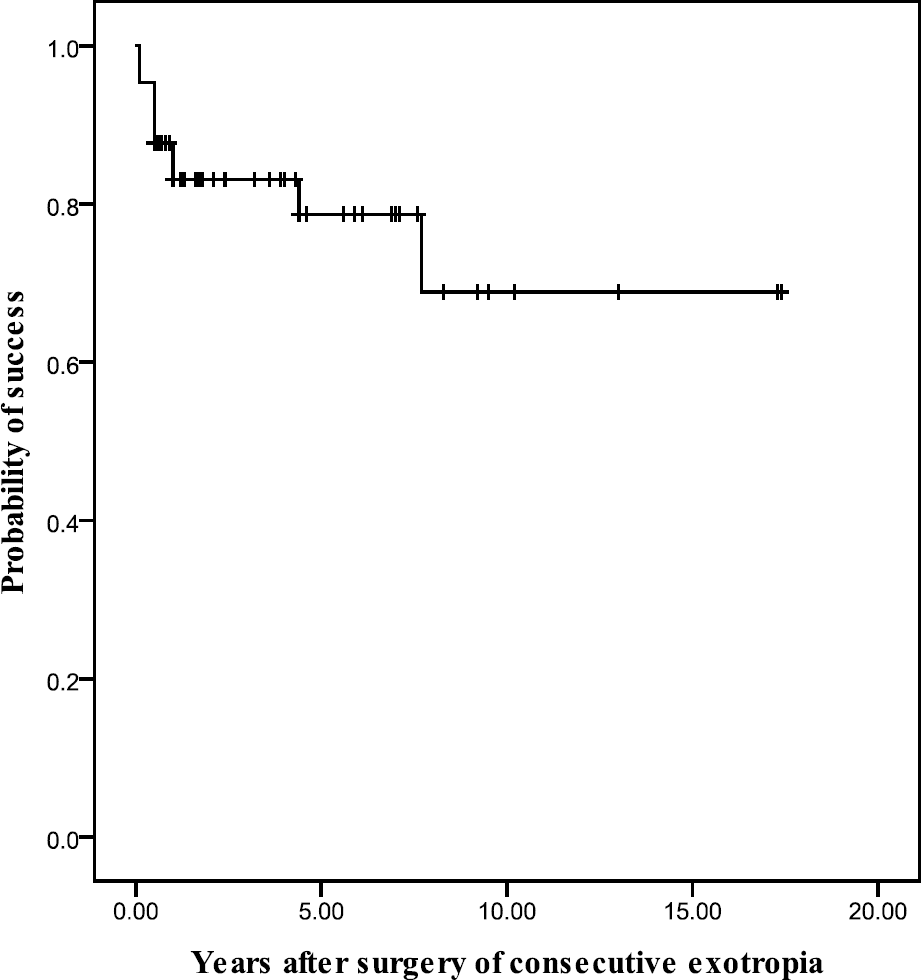1. von Noorden GK, Campos EC. Binocular Vision and Ocular Motility: Theory and Management of Strabismus, 6th ed. St. Louis: Mosby,. 2002; 356–76.
2. Vroman DT, Hutchinson AK, Saunders RA, Wilson ME. Two- muscle surgery for congenital esotropia: rate of reoperation in pa-tients with small versus large angles of deviation. J AAPOS. 2000; 4:267–70.
3. Caputo AR, Guo S, Wagner RS, Picciano MV. Long term fol-low-up of extraocular muscle surgery for congenital esotropia. Am Orthoptic J. 1991; 41:67–71.

4. Burian HM. The principles of surgery on the extraocular muscles: Part I. Fundamental principles: choice of operation in concomitant strabismus: horizontal muscles. Am J Ophthalmol. 1950; 33:380–7.
5. Stoller SH, Simon JW, Lininger LL. Bilateral lateral rectus re-cession for exotropia: a survival analysis. J Pediatr Ophthalmol Strabismus. 1994; 31:89–92.

6. Folk ER, Miller MT, Chapman L. Consecutive exotropia following surgery. Br J Ophthalmol. 1983; 67:546–8.

7. Dunnington JH, Regan EF. Factors influencing the postoperative results in concomitant convergent strabismus. AMA Arch Ophthalmol. 1950; 44:813–22.

8. Forrest MP, Finnigan S, Finnigan S, Gole GA. Three horizontal muscle squint surgery for large angle infantile esotropia. Clin Experiment Ophthalmol. 2003; 31:509–16.

9. Berk AT, Koçak N, Ellidokuz H. Treatment outcomes in refractive accommodative esotropia. J AAPOS. 2004; 8:384–8.

10. Bietie GB, Bagolini B. Problems related to surgical overcorrection in strabismus surgery. J Pediatr Ophthalmol Strabismus. 1965; 2:11–4.
11. Stager DR, Weakley DR Jr, Everett M, Birch EE. Delayed consec-utive exotropia following 7-millimeter bilateral medial rectus re-cession for congenital esotropia. J Pediatr Ophthalmol Strabismus. 1994; 31:147–50. discussion 151-2.

12. Beneish R, Williams F, Polomeno RC, Little JM. Consecutive exo-tropia after correction of hyperopia. Can J Ophthalmol. 1981; 16:16–8.
13. Swan KC. Accommodative esotropia long range follow-up. Ophthalmology. 1983; 90:1141–5.

14. Oğ uz V, Arvas S, Yolar M. . Consecutive exotropia following strabismus surgery. Ophthalmologica. 2002; 216:246–8.

15. Knapp P. The surgical treatment of persistent horizontal strabismus. Trans Am Ophthalmol Soc. 1965; 63:75–90.
16. Ohtsuki H, Hasebe S, Tadokoro Y. . Advancement of medial rectus muscle to the original insertion for consecutive exotropia. J Pediatr Ophthalmol Strabismus. 1993; 30:301–5.

17. Patel AS, Simon JW, Lininger LL. Bilateral lateral rectus recession for consecutive exotropia. J AAPOS. 2000; 4:291–4.

18. Pickering JD, Simon JW, Lininger LL. . Exaggerated effect of bilateral medial rectus recession in developmentally delayed children. J Pediatr Ophthalmol Strabismus. 1994; 31:374–7.

19. Lee JR, Roh YB. The factors affecting consecutive exotropia with angle of 20 prism diopters or more following surgery for esotropia. J Korean Ophthalmol Soc. 1995; 36:1778–83.
20. Biedner B, Yassur Y, David R. Advancement and reinsertion of one medial rectus muscle as treatment for surgically overcorrected esotropia. Binocul Vis. 1991; 6:197–200.
21. Rosenbaum AL, Santiago AP. Clinical Strabismus Management: Principles and Surgical Techniques. Philadelphia: WB Saunders;1999. p. 149–51.
22. Cooper EL. The surgical management of secondary exotropia. Trans Am Acad Ophthalmol Otolaryngol. 1961; 65:595–608.
23. Donaldson MJ, Forrest MP, Gole GA. The surgical management of consecutive exotropia. J AAPOS. 2004; 8:230–6.

24. Rajavi Z, Feizi M, Mughadasifar H. . Surgical results of con-secutive exotropia. J Pediatr Ophthalmol Strabismus. 2013; 50:274–81.

25. Chatzistefanou KI, Droutsas KD, Chimonidou E. Reversal of uni-lateral medial rectus recession and lateral rectus resection for the correction of consecutive exotropia. Br J Ophthalmol. 2009; 93:742–6.

26. Mohan K, Sharma A, Pandav S. Unilateral lateral rectus muscle re-cession and medial rectus muscle resection with or without ad-vancement for postoperative consecutive exotropia. J AAPOS. 2006; 10:220–4.

27. Baek SU, Lee JY. Long-term outcome of surgery for intermittent exotropia. J Korean Ophthalmol Soc. 2013; 54:1079–85.

28. Lee JH, Paik HJ. What to predict favorable long-term sensory out-come after surgery for infantile esotropia? J Korean Ophthalmol Soc. 2014; 55:271–7.
29. Lim SH, Hwang BS, Kim MM. Prognostic factors for recurrence after bilateral rectus recession procedure in patients with inter-mittent exotropia. Eye (Lond). 2012; 26:846–52.

30. Lee JH, Kim MM. Clinical manifestation and surgical outcomes of consecutive exotropia. J Korean Ophthalmol Soc. 2003; 44:1839–45.
31. Beneish R, Flanders M. The role of stereopsis and early post-operative alignment in long-term surgical results of intermittent exotropia. Can J Ophthalmol. 1994; 29:119–24.
32. Ing MR, Okino LM. Outcome study of stereopsis in relation to du-ration of misalignment in congenital esotropia. J AAPOS 2002; 6. 3–8.

33. Bae SH, Choi DG. Clinical features and surgical outcomes of in-fantile esotropia according to the age at surgery. J Korean Ophthalmol Soc. 2008; 49:1961–7.






 PDF
PDF ePub
ePub Citation
Citation Print
Print


 XML Download
XML Download